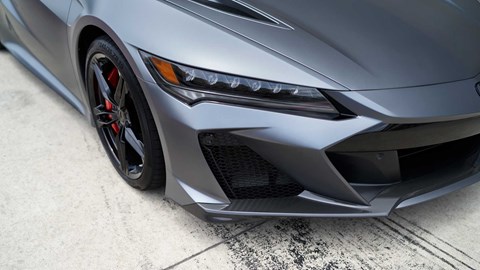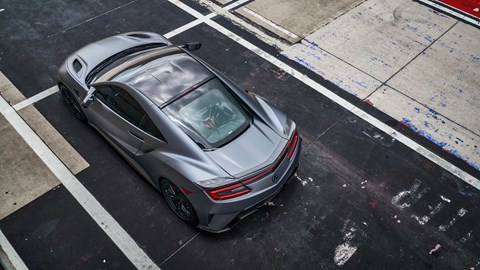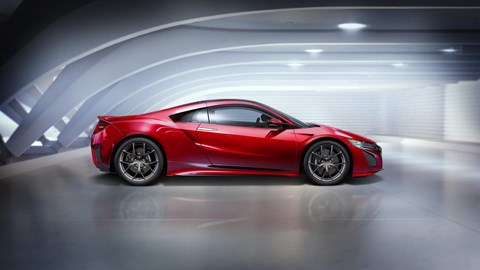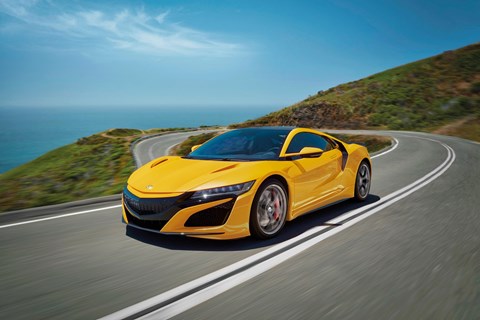► New Honda NSX in detail
► Now there’s a limited Type S
► Honda tech, supercar pace
The NSX is approaching the end of its life, but it’s going to go out with a bang. Honda – or Acura in this case – has revealed a new Type S variant of its hybrid supercar, and it’s both the meanest and fastest NSX ever made for the road. The only catch? Just 350 of the extreme supercars will be made at Honda’s Marysville, Ohio plant – and 300 of them are staying in the US.

Type S?
Honda’s Type S badge usually signifies a softer version of the Type R, but here it’s about ultimate performance. The Type S NSX carries a more aggressive front and rear, with a new diffuser and extra outlets improving the car’s aero balance. It also gets five-spoke wheels, Pirelli P-Zero rubber and a retuned Adaptive Damper system.
Alongside the bodywork upgrades, this NSX also gets Type S decals, a carbonfibre roof as standard and Gotham Grey paint. In fact, there’s a saving of just under 27kg in total.

Underneath, a tweaked version of the standard twin-turbo V6 shares turbochargers with the GT3 car, resulting in a six percent increase in boost pressure. New fuel injectors up the flow race by 25 percent and new intercoolers shrug heat of 15 percent faster. There’s also a ten percent increase in the car’s battery output.

All the above means the Type S kicks out 592bhp and 492lb ft of torque to its uprated 9-speed DCT transmission. That’s about 27bhp and 16lb ft more than the standard car – and it translates to around two second of lap time round Suzuka.
Keep reading for more on the standard car.
Read our review of the new Honda NSX here
Honda NSX: the 2016 return of Honda’s everyday supercar

With ‘more than 550bhp’, the promise of astonishing hybrid-enabled agility and the same focus on accessible, driver-friendly ergonomics that made the original such a groundbreaking machine, the new-generation Honda NSX had the potential to be a landmark supercar when it was launched at the Detroit auto show in 2016.
A US-based development team, working under project leader Ted Klaus, has been flat-out since Acura unveiled its NSX concept in January 2012, making that car’s beguiling shape production-ready while also packaging the required high-performance engineering, cooling and airflow management. Now, three years on – and 26 years after the original NSX was shown to the world – the finished second-generation car has been unveiled.
Our full Honda NSX review
Styling largely intact; performance shifted ‘higher up the food chain’
From the outside, remarkably little has changed. This has to be a good thing, given that lovestruck onlookers heavily outnumbered sniffy dissenters when the concept car did the rounds, though the noticeably larger air intake and exhaust vents speak volumes about the NSX’s cooling requirements – after, all there are one or two components in there.

The heart of the powertrain is a twin-turbo, dry-sumped V6. It drives the rear wheels alone via a nine-speed DCT transmission, its output augmented by three electric motors; one in the transmission housing and also driving the rear axle, and two up front, driving a wheel each. A battery sits low in the chassis, just behind the cockpit, but while the NSX can be driven on electric power alone, it is not a plug-in and its silent range will be modest.
As well as making the NSX four-wheel drive when required, for drama-free hard launches, the three-motor set-up also enables independent, brake-based torque vectoring – or Agile Handling Assist, in Honda parlance. The promise is exceptional agility and stability from a system project leader Ted Klaus reckons works imperceptibly to flatter any driver, Senna-esque or otherwise.
Throughout the gestation of NSX, Klaus has been extremely reluctant to put even ballpark performance figures to his baby, saying only that the benchmarks were the affordable supercar establishment: Porsche 911 Turbo, Ferrari 458 Italia and Audi R8 V10. But he now admits that with ‘more than 550bhp’, the NSX has been moved up the performance food chain, distancing itself from these contemporary rivals and putting oceans of clear water between it and BMW’s similarly-hybrid £95,000, 357bhp i8. And beyond the raw numbers, Klaus talks of the NSX ‘out-performing’ its power-to-weight ratio thanks to its torque-vectoring technology, advanced powertrain and idealised weight distribution.
Fits like a glove, switchable driving modes
The original NSX was criticised for its plain and uninspiring interior, at least until you drove the thing and realised the pay-off was levels of comfort, visibility, usability and ergonomic refinement then unheard of in mid-engined sport cars. The new car’s interior has been designed with the same focus on outstanding ergonomic refinement.

‘The cockpit is arranged to support the driver, and less is more,’ explains Klaus. ‘We’ve gone out of our way to provide excellent outward visibility [those ultra-slim A-pillars], which is a heritage from the original NSX. We also worked to deliver seats with class-leasing support. They work conjunction with the centre console and the door panel to support your lower torso, while giving you freedom of movement in your upper torso.’
Once you’ve made yourself comfortable, the next task it to choose your driving mode. The NSX will offer four modes via a central rotary control: electric-centric Quiet, the default Sport, Sport Plus and Track, which necessarily prioritises powertrain consistency over outright performance. These modes will adjust the usual parameters; acoustics, suspension, powertrain, steering and, potentially, the response of the electro-servo brakes.
Aluminium-intensive body and chassis, like the original
The chassis is an aluminium-intensive spaceframe with strategic use of high-strength steel, notably in the ultra-slim A-pillar. Double-wishbone suspension all-round mounts Brembo ceramic discs, 19 x 8.5in front wheels and 20 x 11in rears.
Honda NSX prices
Further development fine-tuning work will be lavished on Honda’s new performance halo model ahead of deliveries in late 2015, at a price ‘above $150,000’ (£99,000) in the US.
UK prices have crept north since launch and the 2020 Honda NSX now costs a cool £170,000. Is it worth it? Be sure to sound off in the comments below.